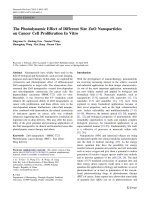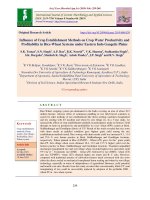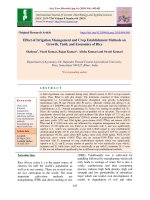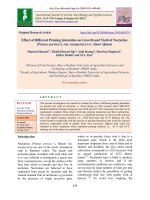Effect of different crop establishment methods on yield attributes, yield and economics
Bạn đang xem bản rút gọn của tài liệu. Xem và tải ngay bản đầy đủ của tài liệu tại đây (158.76 KB, 8 trang )
Int.J.Curr.Microbiol.App.Sci (2020) 9(5): 1663-1670
International Journal of Current Microbiology and Applied Sciences
ISSN: 2319-7706 Volume 9 Number 5 (2020)
Journal homepage:
Original Research Article
/>
Effect of Different Crop Establishment Methods on
Yield Attributes, Yield and Economics
U. Nagabhushanam1* and P. Spandana Bhatt2
1
Regional Agricultural Research Station, Warangal, India
Rice Research Centre, Rajendranagar, Hyderabad, India
2
*Corresponding author
ABSTRACT
Keywords
Rice, Crop
establishment
methods, Grain
yield
Article Info
Accepted:
15 April 2020
Available Online:
10 May 2020
Afield experiment was conducted to study the Effect of different crop
establishment methods on yield attributes, yield and economics of rice
(Oryza sativa L.,) during Kharif, 2017 at Rice Research Centre,
Agricultural Research Institute, Rajendranagar, Hyderabad. The experiment
was laid out in Randomized complete block design with four replications
and five treatments viz., T1- Machine transplanted rice, T2- Manual
transplanted rice in lines, T3- Manual transplanted rice at random, T4- Wet
direct seeded rice-drum seeder, T5- Wet direct seeded rice-broadcasting.
The results revealed that machine transplanted rice proved to be better for
obtaining higher grain yield and net returns as compared to other crop
establishment methods.
Introduction
m t with average productivity 3.2 t/ha
(Statistical year book, 2015).
Rice (Oryza sativa L.,) is one of the most
important and widely cultivated cereal crops
of the world. Of the total global rice
production, 90% was produced and consumed
in Asia and South East Asia. It is not only the
staple food for the rice consumption
population of Indian sub continent got more
than 40% of caloric requirement from the
rice. In India, it is grown on an average of
about 44.4 m ha with a total production of
104 m t and productivity of 2.4 t/ha during
2015-16. In Telangana State, rice occupies
average of 2 m ha area and production of 6.62
Manual transplanting of the seedlings in to
puddle soil is the most common method of
rice crop establishment used by the majority
of farmers of Asian countries. Mahajan et al.,
(2013) stated that there was a severe shortage
of farm labourers during the peak season of
rice transplanting in many rice growing
regions of the Asia, which is aggravating the
problem for rice transplanting results in
delays in transplanting, lower grain yield and
delays in sowing/planting of the next crop
was observed by Pandey and Velasco (2002).
1663
Int.J.Curr.Microbiol.App.Sci (2020) 9(5): 1663-1670
Shortage of farm labourers triggers the search
for alternative rice crop establishment
methods
other
than
conventional
transplanting. Machine transplanting is one of
the few options available for rice crop
establishment
method
having
higher
productivity and profitability.
Mechanical rice transplanter is cost effective
and operational friendly. It helps in
maintaining soil physical properties and
productivity point of view. In spite of having
knowledge over the traditional transplanting,
adoption rate of mechanical transplanters is
low due to high initial investment and lack of
knowledge in growing mat type nursery.
Imparting technical knowledge, ensuring
timely availability and encouraging custom
hiring may be some of the practical solutions
for increasing the rice area under mechanical
transplanting. Hence, transplanting of rice
seedlings with a suitable mechanical
transplanter seems to be most appropriate and
promising avenue and alternate crop
establishment method, as it minimizes
drudgery and saves much of the labour
requirement Vasudevan et al., (2014).
Keeping in view, the present investigation
was carried out for evaluation of rice yield
under different crop establishment methods.
Materials and Methods
A field experiment was carried out during the
Kharif, 2017 at Rice Research Centre,
Agricultural Research Institute, Professor
Jayashankar Telangana State Agricultural
University, Rajendranagar, Hyderabad, India
to study on “Effect of different crop
establishment methods on yield attributes,
yield and economics of rice (Oryza sativa
L.,)”. The experimental site is located at 170
191 North latitude and 780231 East Longitude
and 542.6 m above mean sea level. The
composite soil of experimental site is clay
loam in texture, low in available N 170 kg/ha
(Subbaiah and Asija, 1956), high in available
P 82 kg/ha (Olsen et al., 1954) and available
K 368 kg/ha (1N NH4OAC – extractable K)
with neutral in reaction (pH 7.3) and electrical
conductivity 0.26 ds/m.
The experiment was laid out in Randomized
complete block design with four replications
and five treatments viz., T1- Machine
transplanted rice, T2- Manual transplanted
rice in lines, T3- Manual transplanted rice at
random, T4- Wet direct seeded rice-drum
seeder, T5- Wet direct seeded ricebroadcasting. The test variety RNR-15048
(Telangana Sona) was soaked on 8th July,
incubated on 9th July and sown on 10th July in
nursery for T1, T2, T3, where as soaked,
incubated seeds directly sown in main field
for T4 and T5. The treatment means were
compared using least significant difference at
5% level of significance (Gomez and Gomez,
1984). The economics were also calculated on
the basis of cost of cultivation, gross returns,
net returns and benefit cost ratio. The cost of
cultivation for each treatment was calculated
by summing all the variable cost items in the
production process. Similarly, gross returns
were calculated based on prevailing market
price of the produce. The net returns were
obtained after deducting the cost of
cultivation from gross returns. Thus the
benefit cost analysis was obtained by dividing
total returns from a unit with total cost of a
unit.
Results and Discussion
Plant population
Plant population viz., number of hills/m2 was
influenced significantly by crop establishment
methods. The plants were spaced at specific
distance in T1- 30x12 cm in machine
transplanting (28.2 hills/m2) and T2-15x15 cm
in manual transplanted rice in lines (42
hills/m2) and T4- 25x10 cm in Wet direct
1664
Int.J.Curr.Microbiol.App.Sci (2020) 9(5): 1663-1670
seeded rice-drum seeder where as in T5soaked, incubated seeds were sown by
broadcasting without proper spacing. Manual
transplanted
rice
in
lines
recorded
significantly higher plant population (38
hills/m2) as compared to all other crop
establishment methods, as it is spaced both
inter and intra row space at 15 cm and it is
comparable with T5- Wet direct seeded ricebroadcasting (36.2 hills/m2) and lower plant
population was recorded in T1- Machine
transplanted rice (28.2 hills/m2) as it is having
inter row space 30 cm, intra row space 10 cm.
(Table 1).
Plant height
Plant height was not influenced significantly
by crop establishment methods. Similar plant
height was observed in all the crop
establishment methods.
Days to 50% flowering
Days to 50% flowering was influenced
significantly by crop establishment methods.
Machine transplanted rice taken significantly
higher number of days to 50% flowering as
compared to wet direct seeded rice either by
drum seeder or broadcasting and manual
transplanted rice at random, it remained
comparable with manual transplanted rice in
lines. 17 and 25 days age seedlings were
raised in mat nursery and nursery for machine
transplanted rice, manual transplanted rice in
lines respectively, transplanted in the main
field. Hence, they took more number of days
to 50% flowering, where as in wet direct
seeded rice- broad casting method soaked and
incubated seeds was sown directly in the main
field, days to 50% flowering was reduced as
there was no raising of nursery (Table 1).
Number of tillers/m2
Number
of
tillers/m2
was
significantly by crop establishment methods.
Manual transplanted rice in lines recorded
significantly higher number of tillers/m2
(425.2) over all other crop establishment
methods; it remained at par with wet direct
seeded rice-broadcasting (387.7). Lower
number of tillers/m2 was recorded in Machine
transplanted rice (340.5) (Table 1).
Number of tillers/m2 was significantly higher
because of the reason that plants were spaced
at specific distance and the competition
between the plants was minimum for efficient
utilization of all the available resources, there
by better translocation of photosynthates from
source to sink in manual transplanted rice in
lines.
Number of panicles/m2
Number of panicles/m2 was influenced
significantly by crop establishment methods.
Manual
transplanted
rice
recorded
significantly higher number of tillers/m2
(382.2) as compared to wet direct seeded ricedrum seeder (296.0), manual transplanted rice
at random (305.2), it remained comparable
with machine transplanted rice (333.2) and
wet direct seeded rice-broadcsting (358.0).
Lower number of tillers/m2 was recorded in
wet direct seeded rice- drum seeder (296.0)
(Table 1).
Number of panicles/m2 was significantly
higher in machine transplanted rice and
manual transplanted rice in lines mainly
because of optimum plant population, plant
geometry coupled with transplanting young
seedlings that resulted in even distribution of
available resources viz., sun light, moisture,
nutrients among rice plants leading to better
growth , yield attributes. These results are in
corroborate with the findings of Revathi et al.,
(2016), Pasha et al., (2009) and Ramulu et al.,
(2019).
influenced
1665
Int.J.Curr.Microbiol.App.Sci (2020) 9(5): 1663-1670
Table.1 Growth parameters, Yield attributes and yield as influenced by different crop establishment methods
Treatments
Plant
population
Mechanized
transplanting
Manual
transplanted
rice in lines
Manual
transplanted
rice at random
Wet direct
seeded rice drum seeder
Wet direct
seeded rice broadcasting
SEm ±
28.2
Plant
height
(cm)
100.5
Days to 50
%
flowering
91.3
Tillers
(No/m2)
Panicles
(no/m2)
359.5
38.0
101.5
91.3
425.2
382.2
27.7
3.8
12.0
7949
9508
30.7
100.5
87.3
346.7
305.2
27.5
3.5
11.7
7314
9363
30.0
99.5
87.3
340.5
296.0
26.6
3.2
11.7
5952
7601
36.2
101.3
84.3
387.7
358.0
26.1
3.1
11.0
4478
5802
2.26
0.96
0.26
15.88
296.0
0.25
0.21
0.23
242.38
283.53
CD (p=0.05)
7.04
NS
0.80
49.49
51.98
0.79
NS
NS
755.14
883.33
1666
333.2
Panicle
length
(cm)
28.4
Panicle
weight
(g)
4.0
Test
wt.
(g)
12.1
Grain
yield
(kg/ha)
8161
Straw
yield
(kg/ha)
9771
Int.J.Curr.Microbiol.App.Sci (2020) 9(5): 1663-1670
Table.2 Economics as influenced by crop establishment methods
Treatments
Cost of
cultivation/ha
Gross returns/ha
Net returns/ha
B:C
Mechanized
transplanting
55,000
1,36,275
81,275
1.48
Manual transplanted
rice in lines
54,800
1,32,718
77,918
1.42
Manual transplanted
rice at random
53,000
1,22,742
69,242
1.29
Wet direct seeded drum seeder
51,500
99,869
48,369
0.94
Wet direct seeded rice
- broadcasting
48,000
75,215
27,215
0.57
results were also reported by Kumhar et al.,
(2016).
Panicle length
Panicle length influenced significantly by
crop establishment methods. Machine
transplanted rice recorded significantly higher
panicle length (28.4 cm) as compared to
direct seeded rice either by drum seeder or
broadcasting; it remained at par with manual
transplanting in lines (27.5 cm) or at random
(27.5 cm). Lower panicle length was recorded
in wet direct seeded rice-broadcasting (26.1
cm). (Table 1).The significant improvement
in panicle length might be due to lower
competition for available resources space,
sunlight, moisture, nutrients etc. Similar
Panicle weight
Panicle weight did not influence significantly
by crop establishment methods. Machine
transplanted rice recorded marginally higher
panicle weight (4.0 g) as compared to all
other crop establishment methods; Lower
panicle weight (3.1 g) was recorded in wet
direct seeded rice-broadcasting.
The higher panicle weight in machine
transplanting might be due to lower
competition for available resources i.e., space,
1667
Int.J.Curr.Microbiol.App.Sci (2020) 9(5): 1663-1670
sun light, moisture, nutrients etc. Similar
results were also reported by Kumhar et al.,
(2016).
Test weight
Test weight though did not influence
significantly by crop establishment methods,
machine
transplanted
rice
recorded
substantially higher test weight (12.1 g)
followed by manual transplanted rice lines
(12.0 g) (Table 1). These results were also
reported by Pasha et al., (2009), Sreenivasulu
et al., (2014), Ramulu et al., (2019).
Grain yield
Grain yield influenced significantly by crop
establishment methods. Machine transplanted
rice recorded significantly higher grain yield
(8161 kg/ha) as compared to all other crop
establishment
methods;
it
remained
comparable with manual transplanted rice in
lines (7949 kg/ha). Lower grain yield was
recorded in wet direct seeded ricebroadcasting (4478 kg/ha).
Higher grain yield in machine transplanted
rice was mainly due to better vegetative
growth, dry matter accumulation and effective
partitioning to the panicles resulting in more
number of panicles/m2, higher test weight
which ultimately improved grain yield. The
increase in grain yield of rice in machine
transplanting was in agreement with the
results reported by Revathi et al., (2016),
Satish et al., (2016) and Ramulu et al.,
(2019).
Straw yield
Straw yield was influenced significantly by
crop establishment methods. Machine
transplanting recorded significantly higher
straw yield (9771 kg/ha) as compared to wet
direct seeded rice either by drum seeder (7601
kg/ha) or broad casting (5802 kg/ha), it
remained
comparable
with
manual
transplanted rice in lines (9508 kg/ha) or at
random (9363 kg/ha). Higher straw yield in
machine transplanted rice was mainly because
of better establishment of seedlings, increased
vegetative growth, higher dry matter
accumulation, effective partitioning and more
number of tillers/m2 which ultimately
improved the straw yield. Similar results were
also reported by Revathi et al., (2016), Satish
et al., (2016) and Ramulu et al., (2019).
Economics
Among the crop establishment methods,
lowest cost of cultivation was recorded in wet
direct seeded rice-broadcasting (Rs.48, 000).
The cost of cultivation was higher in machine
transplanted rice (Rs.55, 000) as well as
manual transplanted rice in lines (Rs.54, 000).
due to raising of nursery on polythene sheet
and involvement of more human labour. The
net returns (Rs. 81,275) as well as return per
rupee invested (1: 1.48) is maximum in
machine transplanted rice. The higher yields
of grain and straw recorded in machine
transplanted rice was the main reason for
higher benefit cost ratio though cost of
cultivation was higher than manual
transplanted rice in lines
On the basis of results obtained from the
present investigation, it is concluded that rice
is grown mostly through manual transplanting
in India, inspite of the fact that manual
transplanting is cumbersome practice and
requires more labour. The inadequacy of
scarce labour coupled with higher wages
during the peak period of farm operations,
invariably led to delay in transplanting. To
overcome this problem, farmers are gradually
switching over to alternate crop establishment
methods.
1668
Int.J.Curr.Microbiol.App.Sci (2020) 9(5): 1663-1670
Machine transplanting is an alternate crop
establishment method to conventional manual
transplanting, as it saves labour, ensures
timely transplanting and attains optimum
plant population to increasing the productivity
and profitability, proved better compared to
other crop establishment methods.
References
Gomez KA, Gomez AA 1984. Statistical
Procedures for Agricultural Research,
2nd Edition. John Wiley and Sons. New
York.; p:639.
Kumhar BL, Chavan VG, Rajemahadik VA,
Kande VM, DHopavkar RV, Ameta HK
and Tilekar RN 2016. Effect of different
rice establishment methods on growth,
yield and different varieties during
Kharif season. International Journal of
Plant, Animal and Environmental
Sciences. 6(2): 127-131.
Mahajan G, Chauhan BS, Gill MS 2013. Dry
seeded rice culture in Punjab state of
India; Lessons learned from farmers.
Field Crop Research. 144; 89-99.
Pandey S and Velasco L 2002. Economics of
direct seeding in Asia. Patterns of
adoption and research properties in
Direct Seeding: Research Strategies and
Opportunities.
International
Rice
Research
Institute,
Los
Banos,
Philippines; 3-14.
Pasha MDL, Raghu Rami Reddy P, Badru D
and Krishna L 2009. Evaluation of
different crop establishment techniques
in puddle rice (Oryza sativa L.,). The
journal of Research Acharya NG Ranga
Agricultural University. 42(2): 13-16.
Ramulu Ch, Raghu Rami Reddy P and
Narsaiah E 2019. Effect of different
establishment methods and nitrogen
levels on yield attributes, yield, nutrient
uptake and economics of rice (Oryza
sativa L.,). The journal of Research
PJTSAU. 47(3): 27-32.
Revathi P, Suneetha Devi KB, Gopal Reddy
B, Praveen Rao V, Padmaja G and
Shivashankar A 2016. Influence of
planting methods and integrated nutrient
management
practices
on
yield
attributes, yield and economics of rice
(Oryza sativa L.,). The journal of
Research PJTSAU. 44(4): 25-32.
Satish A, Raghu Rami Reddy P, Avil Kumar
K and Uma Devi M 2016. Dry matter
production and nutrient uptake of rice
(Oryza sativa L.,). As influenced by
systems of rice cultivation and irrigation
regimes in puddle soil. The journal of
Research PJTSAU. 44(3): 46-49.
Sreenivasulu S, Bala Hussain Reddy P 2014.
Effect of mechanized transplanting on
yield, yield attributes and economics of
rice (Oryza sativa L.,). The journal of
Research
Acharya
NG
Ranga
Agricultural University. 42(2): 9-12.
Statistical Year Book. 2015. Directorate of
Economics and Statistics, Government
of Telanagana, Hyderabad.
Vasudevan SN, Basan gouda, Mathad RC,
Dodda goudar SR and Shakuntala NM
2014. Standardization of seeding
characteristics for paddy transplanter.
Journal of Advanced Agricultural
Technologies. 1(2); 141-146.
1669
Int.J.Curr.Microbiol.App.Sci (2020) 9(5): 1663-1670
How to cite this article:
Nagabhushanam, U. and Spandana Bhatt, P. 2020. Effect of Different Crop Establishment
Methods
on
Yield
Attributes,
Yield,
Nutrient
Uptake
and
Economics.
Int.J.Curr.Microbiol.App.Sci. 9(05): 1663-1670. doi: />
1670







![Effect of different plant growth regulators on shooting of stem cuttings in dragon fruit [Hylocereus undatus (Haworth) Britton & Rose]](https://media.store123doc.com/images/document/2020_01/09/medium_isb1578564896.jpg)

